Note
Go to the end to download the full example code. or to run this example in your browser via Binder
Explore SESAME alternative inverse solutions on evoked data¶
In this example we shall show that SESAME is able to provide alternative solutions with non-negligible probabilities and how the user can easily explore all of them.
To do so, we shall once again apply SESAME on an evoked dataset, corresponding to the response to an auditory stimulus. Data are taken from the MNE-Python sample dataset.
# Author: Gianvittorio Luria <luria@dima.unige.it>
#
# License: BSD (3-clause)
# sphinx_gallery_thumbnail_number = 2
from os import path as op
import numpy as np
import matplotlib.pyplot as plt
from mne.datasets import sample
from mne import read_forward_solution, pick_types_forward, read_evokeds
from sesameeg.mne import prepare_sesame
data_path = sample.data_path()
subject = 'sample'
subjects_dir = op.join(data_path, 'subjects')
fname_fwd = op.join(data_path, 'MEG', subject,
'sample_audvis-meg-eeg-oct-6-fwd.fif')
fname_evoked = op.join(data_path, 'MEG', subject, 'sample_audvis-ave.fif')
Load the forward solution  and the evoked data
and the evoked data
 .
The forward solution also defines the employed brain discretization.
.
The forward solution also defines the employed brain discretization.
meg_sensor_type = True # All MEG sensors will be included
eeg_sensor_type = False
# Forward solution
fwd = read_forward_solution(fname_fwd, exclude='bads')
fwd = pick_types_forward(fwd, meg=meg_sensor_type,
eeg=eeg_sensor_type, ref_meg=False)
# Evoked Data
condition = 'Left Auditory'
evoked = read_evokeds(fname_evoked, condition=condition, baseline=(None, 0))
evoked = evoked.pick('meg', exclude='bads')
Reading forward solution from /home/pasca/mne_data/MNE-sample-data/MEG/sample/sample_audvis-meg-eeg-oct-6-fwd.fif...
Reading a source space...
Computing patch statistics...
Patch information added...
Distance information added...
[done]
Reading a source space...
Computing patch statistics...
Patch information added...
Distance information added...
[done]
2 source spaces read
Desired named matrix (kind = 3523 (FIFF_MNE_FORWARD_SOLUTION_GRAD)) not available
Read MEG forward solution (7498 sources, 306 channels, free orientations)
Desired named matrix (kind = 3523 (FIFF_MNE_FORWARD_SOLUTION_GRAD)) not available
Read EEG forward solution (7498 sources, 60 channels, free orientations)
Forward solutions combined: MEG, EEG
Source spaces transformed to the forward solution coordinate frame
364 out of 366 channels remain after picking
305 out of 364 channels remain after picking
Reading /home/pasca/mne_data/MNE-sample-data/MEG/sample/sample_audvis-ave.fif ...
Read a total of 4 projection items:
PCA-v1 (1 x 102) active
PCA-v2 (1 x 102) active
PCA-v3 (1 x 102) active
Average EEG reference (1 x 60) active
Found the data of interest:
t = -199.80 ... 499.49 ms (Left Auditory)
0 CTF compensation matrices available
nave = 55 - aspect type = 100
Projections have already been applied. Setting proj attribute to True.
Applying baseline correction (mode: mean)
Define the parameters.
time_min, time_max = 0.045, 0.135 # Select N100m
sample_min, sample_max = evoked.time_as_index([time_min, time_max],
use_rounding=True)
# Fix the random seed
np.random.seed(3)
# Manually set the noise standard deviation value. We are intentionally
# overestimating the parameter with respect to SESAME’s default.
noise_std = 0.64 * np.max(abs(evoked.data))
# If None, dip_mom_std will be estimated by SESAME.
dip_mom_std = None
Visualize the selected data.
fig = evoked.plot(show=False)
for ax in fig.get_axes()[:2]:
ax.axvspan(time_min, time_max, alpha=0.3, color="#66CCEE")
plt.show()
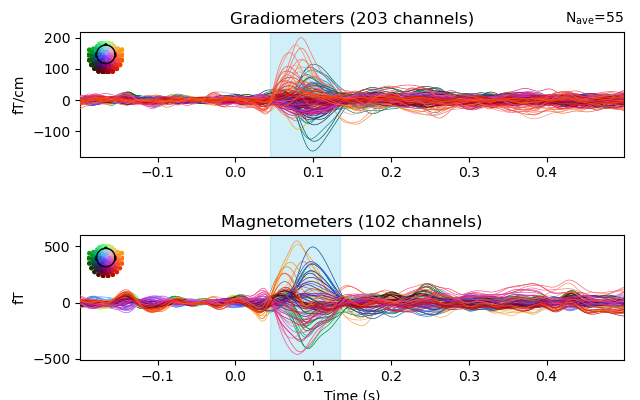
Apply SESAME.
_sesame = prepare_sesame(fwd, evoked, noise_std=noise_std,
top_min=time_min, top_max=time_max,
dip_mom_std=dip_mom_std, hyper_q=True,
subject=subject, subjects_dir=subjects_dir)
_sesame.apply_sesame()
# Compute goodness of fit
gof = _sesame.goodness_of_fit()
print(' Goodness of fit with the recorded data: {0}%'.format(round(gof, 4) * 100))
# Compute source dispersion
sd = _sesame.source_dispersion()
print(' Source Dispersion: {0} mm'.format(round(sd, 2)))
Computing inverse operator with 305 channels.
305 out of 305 channels remain after picking
Forward model with free source orientation.
Computing neighbours matrix [done]
Computing neighbours probabilities...[done]
Analyzing data from 0.045 s to 0.1349 s
Estimating dipole moment std...[done]
Estimated dipole moment std: 3.2335e-08
Sampling hyperprior for dipole moment std.
User defined noise std: 1.2795e-11
Computing inverse solution. This will take a while...
/home/pasca/Tools/python/packages/sesameeg/sesameeg/particles.py:175: RuntimeWarning: invalid value encountered in log
self.loglikelihood_unit = - (n_ist * noise_std**2) * np.log(det_sigma)
Estimated dipole strength variance: 1.53775249467356e-08
Estimated number of sources: 1
Estimated source locations:
* source 1: [0.04930186 0.0095755 0.06843461]
[done in 45 iterations]
Goodness of fit with the recorded data: 21.41%
Source Dispersion: 3.68 mm
Visualize the marginal probability of the number of sources
_sesame.plot_source_number(kind='pie')
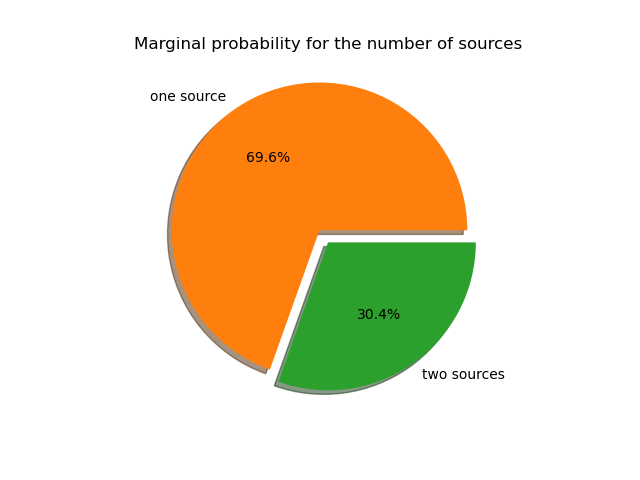
Visualize the posterior map of the dipoles’ location
 and the estimated sources on the inflated brain.
and the estimated sources on the inflated brain.
_sesame.plot_sources(plot_kwargs={'distance': 650})
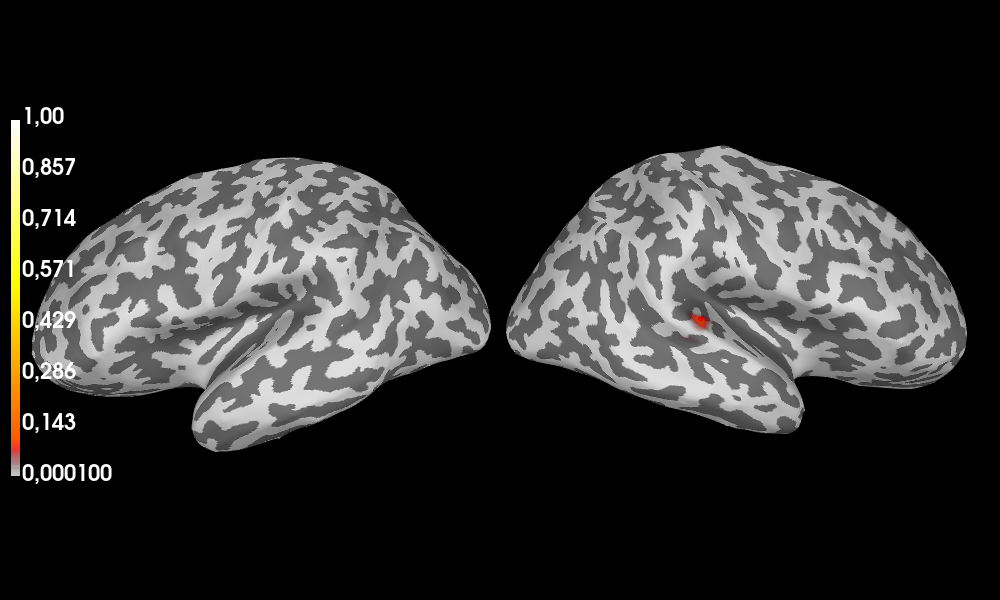
Surface stc computed.
Visualize the amplitude of the estimated sources as function of time.
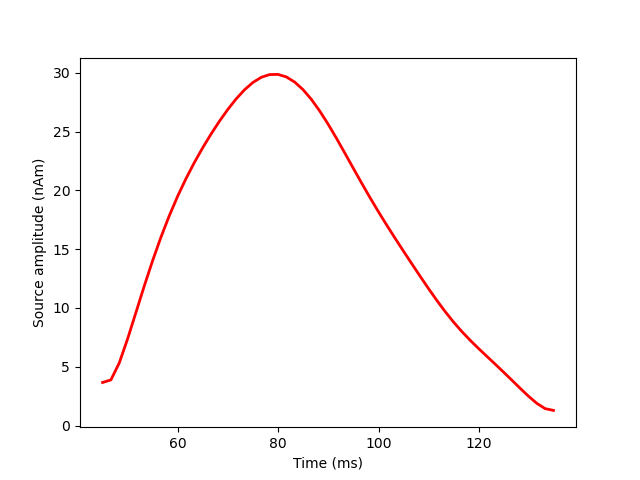
Explore the alternative scenario
_sesame.plot_sources(n_sources=2, plot_kwargs={'distance': 650})
_sesame.plot_source_amplitudes(n_sources=2)
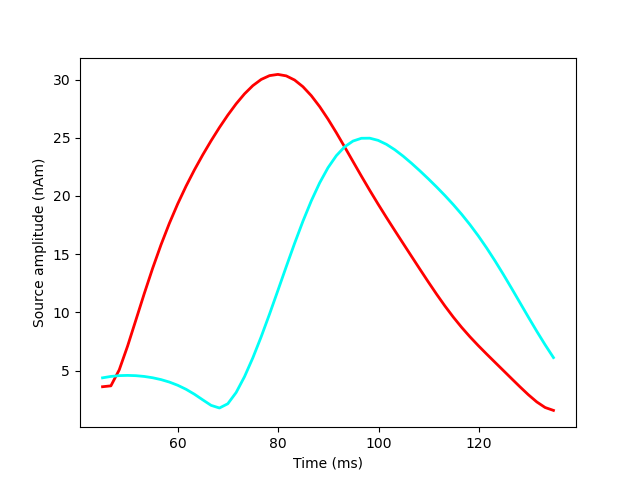
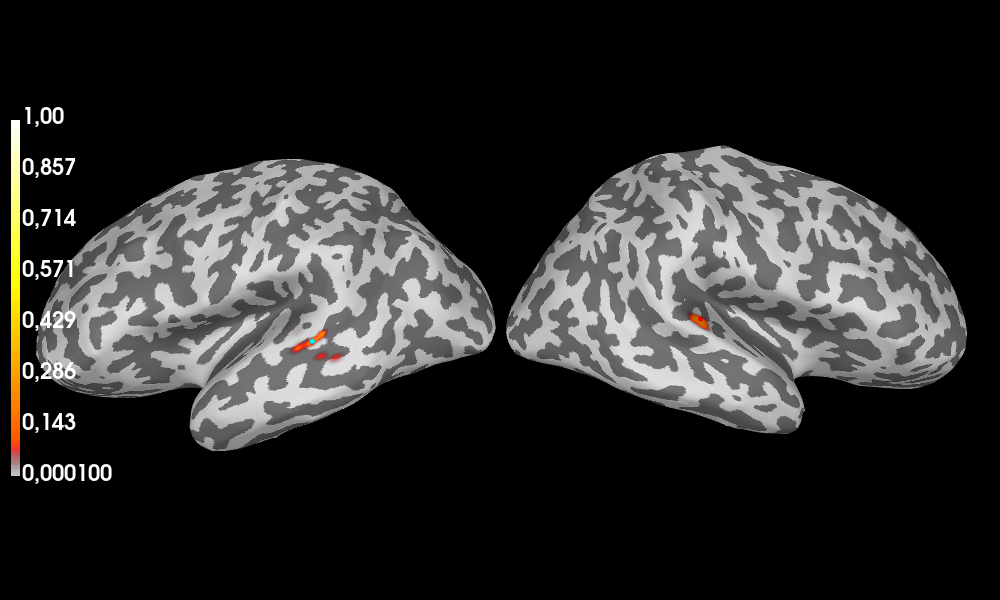
Computing point estimates for user defined source configuration.
Selected number of sources: 2
Estimated source locations:
* source 1: [0.04930186 0.0095755 0.06843461]
* source 2: [-0.05630193 0.00230887 0.05666819]
Surface stc computed.
Computing point estimates for user defined source configuration.
Total running time of the script: (0 minutes 36.859 seconds)